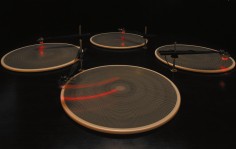Paul DEMARINIS
The Edison Effect
source: v2nl
In the sound sculpture The Edison Effect by American sound artist Paul DeMarinis, old gramophone records, wax cylinders and holograms are scanned with lasers to produce faint music. Thomas Alva Edison (1847-1931), best known as the inventor of the light bulb, was perceived as a charlatan in the scientific community. His discovery of sound recording and invention of the phonograph significantly affected our sense of time. With the phonograph Edison created a mechanical model not for hearing, but for remembering..
.
.
.
.
.
.
.
source: webstanfordedu
Paul DeMarinis has been making noises with wires, batteries and household appliances since the age of four. He has presented his installations, performances and public artworks widely. He teaches art at Stanford University in California.
The old website is gone. In the meantime I suggest you access all information about my work via a lovely book that has just been published. It contains everything my old website did and much more, including fascinating essays by Gascia Ouzounian, Douglas Kahn, Fred Turner, Bernd Schulz, Thomas Levin, Erkki Huhtamo and Siegfried Zielinsky. Titled “Buried in Noise” it is hardbound, has 288 pages, is edited by Carsten Seiffarth and Ingrid Beierer, published by Kehrer Verlag and available at your favorite online retailer.
.
.
.
.
.
.
.
source: artstanfordedu
Paul DeMarinis has been working as an electronic media artist since 1971 and has created numerous performance works, sound and computer installations and interactive electronic inventions. One of the first artists to use computers in performance, he has performed internationally, at The Kitchen, Festival d’Automne a Paris, Het Apollohuis in Holland and at Ars Electronica in Linz and created music for Merce Cunningham Dance Co. His interactive audio artworks have been exhibited at the I.C.C. in Tokyo, Bravin Post Lee Gallery in New York, The Museum of Modern Art in San Francisco and the 2006 Shanghai Biennale. He has received major awards and fellowships in both Visual Arts and Music from The National Endowment for the Arts, N.Y.F.A., N.Y.S.C.A., the John Simon Guggenheim Foundation, the Rockefeller Foundation and was awarded the Golden Nica for Interactive Art at Ars Electronica in 2006. Much of his recent work deals with the areas of overlap between human communication and technology. Major installations include “The Edison Effect” which uses optics and computers to make new sounds by scanning ancient phonograph records with lasers, “Gray Matter” which uses the interaction of flesh and electricity to make music, “The Messenger” that examines the myths of electricity in communication and recent works such as “RainDance” and “Firebirds” that use fire and water to create the sounds of music and language. Public artworks include large scale interactive installations at Park Tower Hall in Tokyo, at the Olympics in Atlanta and at Expo in Lisbon and an interactive audio environment at the Ft. Lauderdale International Airport. He has been an Artist-in-Residence at The Exploratorium and at Xerox PARC and is currently a Professor of Art at Stanford University in California.


